MSI P55-GD65 - Mid-Range P55 for the Masses
by Gary Key on October 10, 2009 12:00 PM EST- Posted in
- Motherboards
Networking
The Windows 2000 Driver Development Kit (DDK) includes a useful LAN testing utility called NTttcp. We used the NTttcp tool to test Ethernet throughput and the CPU utilization of the various Ethernet Controllers used on the Intel motherboards. We set up one machine as the server; in this test, an Intel system with an Intel CSA Gigabit LAN connection. Intel CSA has a reputation for providing fast throughput and is a logical choice for our Gigabit LAN server.
On the server side, we used the following Command Line as suggested by the VIA whitepaper on LAN testing:
Ntttcpr -m 4,0,‹server IP› -a 4 -l 256000 -n 30000
On the client side (the motherboard under test), we used the following Command Line:
Ntttcps -m 4,0,‹client IP› -a 4 -l 256000 -n 30000
At the conclusion of the test, we captured the throughput and CPU utilization figures from the client screen.
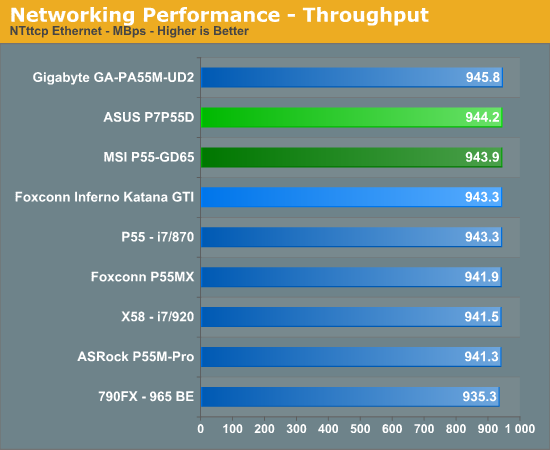
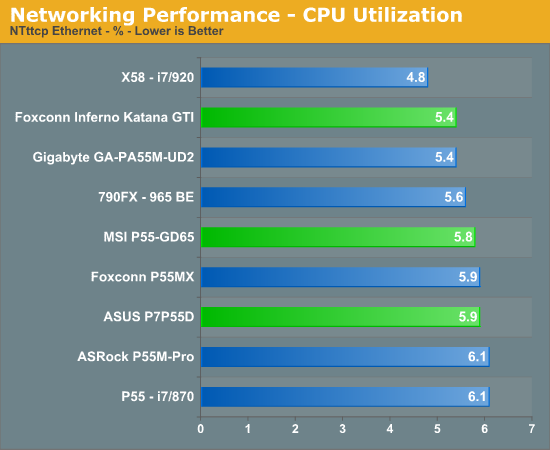
Our network throughput test indicates how well a particular controller design from Realtek, Marvell, or Intel performs instead of being indicative of true chipset performance. This also holds true for the CPU utilization results, though this test can also be influenced to certain degree by the BIOS code and chipset interconnect design.
The CPU utilization and throughput numbers favor the Realtek controller on the Gigabyte board, followed closely by the same Realtek chipset on the Foxconn and ASRock boards. In practice, few if any users will notice a difference, even if they have the requisite gigabit hub, as storage performance frequently bottlenecks the actual transfer rates.
For our second series of networking tests we utilize a Promise SmartStor NS4600 NAS unit equipped with two WD Caviar Black 640GB drives in RAID 1 operation. We are using two benchmarks from Intel’s popular NASPT 1.70 testing tool. The Promise NAS unit is connected to each test platform via a NetGear Gigabit Ethernet switch. We left all settings at their defaults on both the motherboard and Promise NAS unit. Our goal was to maximize the performance of the NAS unit to verify our network throughput capabilities on each motherboard.
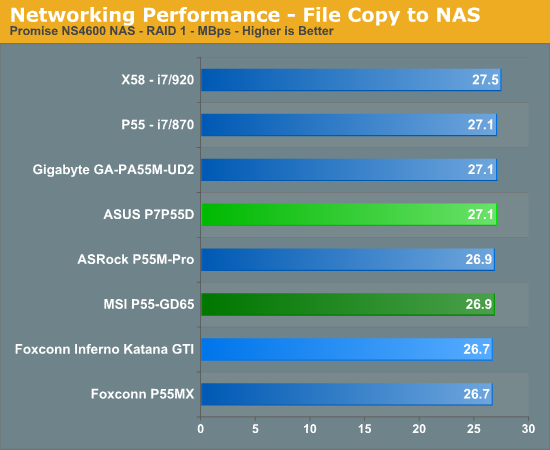
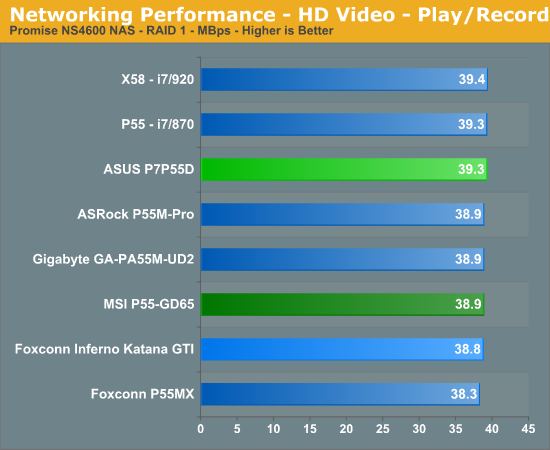
Our three P55 test subjects perform almost identically in our actual usage tests.
USB / FireWire Performance
Our USB transfer speed tests are conducted with an USB 2.0/FireWire based Lacie external hard drive unit featuring a 1TB 7200rpm Samsung drive. In the SSD to External test, we transfer a 3.82GB folder containing 2735 files of various sizes from our Kingston 80GB SSD to the Lacie drive. In the next two file tests, we use the same 3.82GB folder to transfer from our WD VRaptor 300GB hard drive to the external Lacie drive utilizing the USB 2.0 and IEEE 1394a interface.
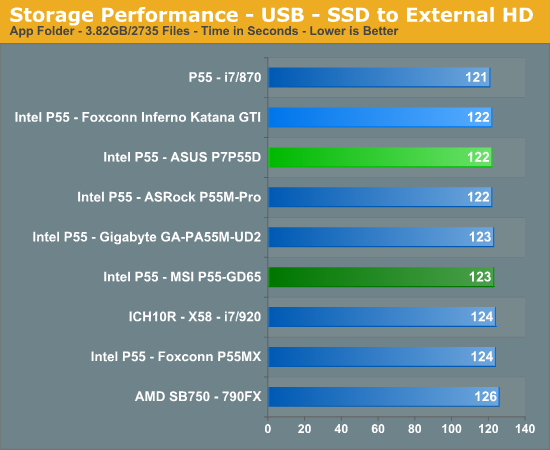
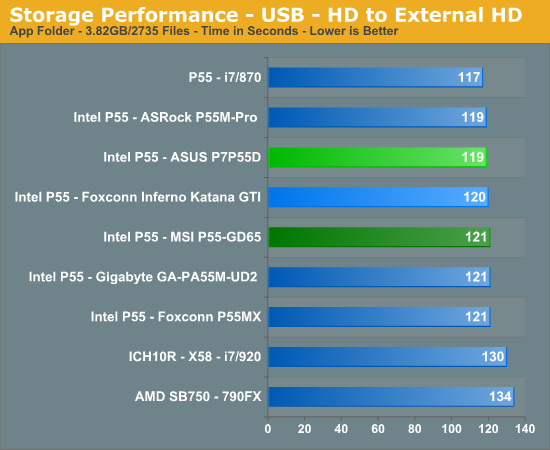
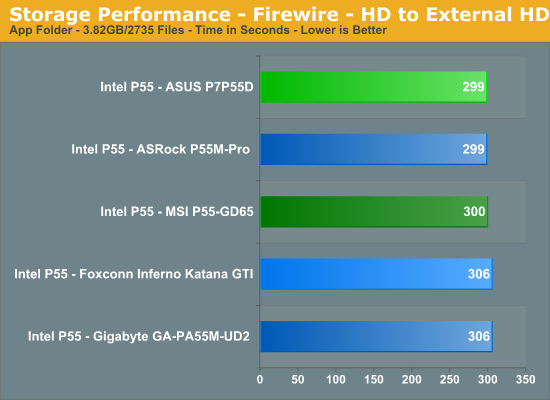
The MSI board performs in the middle of the pack in our USB tests. The VIA Firewire controller on the MSI board has a slightly higher write speed (+3Mb/s) under HDTach/HDTune and it shows up in our file transfer test compared to the Gigabyte/Foxconn boards.
Storage Performance
In our storage test, we utilize the same 3.82GB test folder and transfer it from our WD VRaptor drive to our Kingston 80GB SSD.
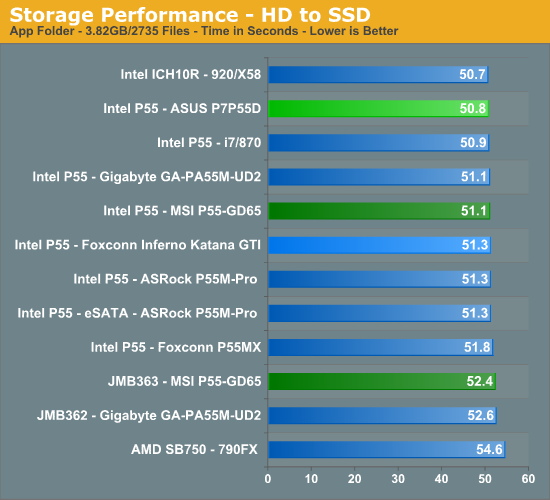
Once again, our P55 motherboards perform almost identically. The P55 chipset on the MSI board has a 3% advantage over the JMicron controller on the same board. However, any measurable differences were not recognized in actual usage.










43 Comments
View All Comments
MadMan007 - Monday, October 12, 2009 - link
er *video performance test. Whatever, not the place I'd expect to read about motherboard features or stuff that I'd epect to find in, ya know, regular motherboard reviews.vlado08 - Sunday, October 11, 2009 - link
Gary, give us the POST time ot the boards. Not the OS load time but the POST time. And Sata to be in AHCI mode.Sunburn74 - Saturday, October 10, 2009 - link
This really was a great review. You tell the end user pretty much everything he needs to know. I love how you tested S3 resume. Its very frustrating to buy a board said to have great overclocking and find that you can only overclock 300mhz before S3 sleep goes haywire. If this board can be pushed to 190blck before S3 goes awry that is amazingly good. Gigabyte boards give you about 600mhz of head room before they start failing in that regard. I don't know about you, but I don't like having to to weigh the value of keeping a 4ghz processor vs being able to have a computer that sleeps.Also what gives with the floppy and the ide ports? Who still uses floppies?
Great review. I'll definitely keep this board in sight for when I build my p55 rig.
lopri - Sunday, October 11, 2009 - link
Gary now writes practically critic-proof reviews.Zaitsev - Saturday, October 10, 2009 - link
Who still uses floppies? I still use floppies. I was pretty perturbed when I realized my P55 Asus board didn't have floppy support. Call me old school, but its compatible and works when you need sata drivers.MadMan007 - Sunday, October 11, 2009 - link
Well I can see how floppy is deprecated unless you need drivers for XP (old now, although WHS needs a floppy for F6 drivers) or an alternative OS (not sure about the latter) but I'm with you on IDE. If they're going to have a JMicron controller on the board might as well include the IDE connector, it probably adds almost nothing more to the cost.There are particular instances where having an IDE optical drive is beneficial. I set up my SATA drives as AHCI and some bootable ISOs do not play well with AHCI (or RAID) setting. I do have a SATA optical but having an IDE optical for booting such ISOs without having to mess around in the BIOS is nice and it guarantees compatability. I guess you could use a SATA optical on the JMicron set to IDE but I had the IDE drive so...
I think it's funny that someone would 'look down on' a board for having an IDE connector..wtf? It's not hurting anything being there, just ignore it.
Makaveli - Sunday, October 11, 2009 - link
Who still uses Floopies I do!! I won't do a bios flash on my motherboard from windows or flashing a videocard bios!!!However there are these really great devices called USB thumb drives which you can make bootable and guess what goodbye floppy!!
The only valid reason to keep using them is if your board doesn't allow booting from USB!
Welcome to 2009!
stmok - Sunday, October 11, 2009 - link
Floppy disk for SATA drivers?Can't you slipstream them in a customised Windows install CD via nLite/vLite? (I've only seen it done to a WinXP install CD.)
MadMan007 - Sunday, October 11, 2009 - link
Good luck running nLite or vLite without an OS installed! ;) That's what second computers are for but still...tony montana - Saturday, October 10, 2009 - link
I old school too. The same on IDE. why I have to spend some bucks on a new DVD burner for 4 or 5 burns a year?This board has at least these ports at the right place for me, not on the bottom like others.
thanks for review, is one of the two mobos I have in mind to purchase and I have seen some tips I haven´t see in others reviews